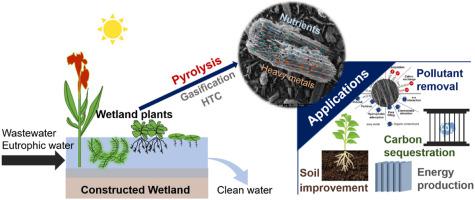Chemosphere ( IF 8.1 ) Pub Date : 2021-09-14 , DOI: 10.1016/j.chemosphere.2021.132259 Xiaoqiang Cui 1 , Jiangtao Wang 1 , Xutong Wang 1 , Muhammad Bilal Khan 2 , Min Lu 2 , Kiran Yasmin Khan 3 , Yingjin Song 1 , Zhenli He 4 , Xiaoe Yang 2 , Beibei Yan 1 , Guanyi Chen 5

|
Constructed wetland is considered a promising approach for water remediation due to its high efficiency, low operation costs, and ecological benefits, but the large amounts of wetland plant biomass need to be properly harvested and utilized. Recently, wetland plant derived biochar has drawn extensive attention owing to its application potential. This paper provides an updated review on the production and characteristics of wetland plant derived biochar, and its utilization in soil improvement, carbon sequestration, environmental remediation, and energy production. In comparison to hydrothermal carbonization and gasification, pyrolysis is a more common technique to convert wetland plant to biochar. Characteristics of wetland plant biochars varied with plant species, growth environment of plant, and preparation conditions. Wetland plant biochar could be a qualified soil amendment owing to its abundant nutrients. Notably, wetland plant biochar exhibited considerable sorption capacity for various inorganic and organic contaminants. However, the potentially toxic substances (e.g. heavy metal and polycyclic aromatic hydrocarbons) retained in wetland plant biochar should be noticed before large-scale application. To overcome the drawbacks from the scattered distribution, limited productivity, and seasonal operation of constructed wetlands, the economic feasibility of wetland plant biochar production system could be improved via using mobile pyrolysis unit, utilizing local waste heat, and exploiting all the byproducts. Future challenges in the production and application of wetland plant derived biochar include the continuous supply of feedstock and proper handling of potentially hazardous components in the biochar.
中文翻译:

来自人工湿地生物质废物的生物炭:对其潜力和挑战的回顾
人工湿地因其高效、低运营成本和生态效益而被认为是一种很有前景的水体修复方法,但需要适当收获和利用大量湿地植物生物量。近年来,湿地植物衍生的生物炭因其应用潜力而受到广泛关注。本文对湿地植物源生物炭的生产和特性及其在土壤改良、固碳、环境修复和能源生产中的利用进行了最新综述。与水热碳化和气化相比,热解是一种更常见的将湿地植物转化为生物炭的技术。湿地植物生物炭的特性因植物种类、植物生长环境和制备条件而异。湿地植物生物炭由于其丰富的营养成分,是一种合格的土壤改良剂。值得注意的是,湿地植物生物炭对各种无机和有机污染物表现出相当大的吸附能力。然而,在大规模应用之前,应注意湿地植物生物炭中残留的潜在有毒物质(如重金属和多环芳烃)。为克服人工湿地分布分散、产能有限、季节性运行等弊端,通过使用移动式热解装置,利用当地余热,开发所有副产品,提高湿地植物生物炭生产系统的经济可行性。











































 京公网安备 11010802027423号
京公网安备 11010802027423号